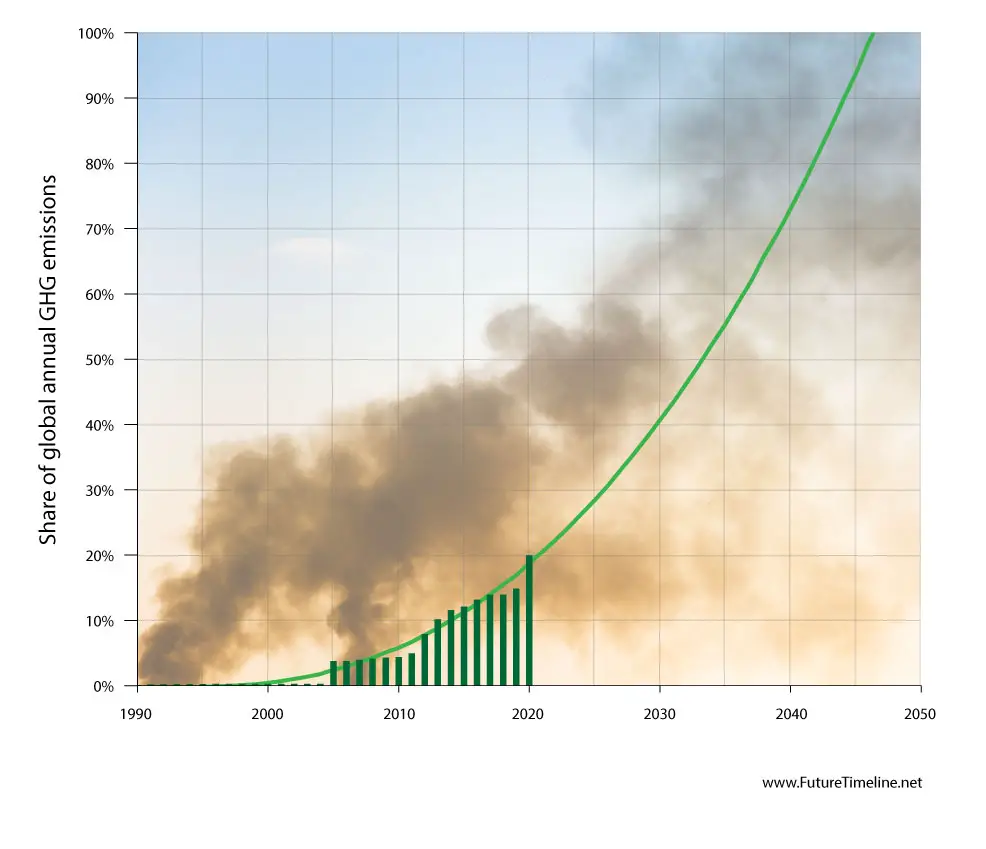
|
|
|
|
|
|
2046
Close approach of the asteroid 2023 DW
On 14th February 2046,* an asteroid measuring 50 metres in diameter approaches the Earth-Moon system at high speed. The object, first discovered by astronomers in 2023, is designated 2023 DW. It belongs to the Aten group, which consists of bodies with a semi-major axis of roughly 1.0 astronomical unit (AU) or less, i.e. the average distance from Earth to the Sun.
When first identified, scientists at the European Space Agency put 2023 DW at number one place on their "risk list" of potentially hazardous objects, due to its Earth-crossing orbit. NASA calculated the odds of impact at 1 in 560, or about a 0.18% chance.
Although unlikely to collide, its mass and speed meant that such an event had the potential to do significant damage. Moving at 24.6 km/s (15.3 mi/s) or about 88,700 km/hr (55,100 mph), a hit would produce energy equivalent to 4 megatons of TNT, enough to destroy a New York-sized city. For comparison, the ancient Meteor Crater site in Arizona involved an object of similar size, resulting in a crater of 0.7 miles (1.2 km).
Based on 55 observations, astronomers produced a "risk corridor" spread mainly across the Pacific Ocean, but including the south of Hawaii, plus another potential danger zone across the north of Mexico and the southern United States.
Shortly after these studies, 2023 DW became more difficult to observe due to its position in relation to the Moon. However, subsequent observations refined its trajectory and provided more certainty of its path in 2046.
The UK state pension age has risen to 70
Due to increases in life expectancy, and unsustainable levels of age-related spending, the UK's state pension age has risen from 65 in 2012, to 70 now.* This provides a net benefit to the public finances of around 0.7% of GDP.

The Gaza Strip has been cleared of debris and explosive remnants
By 2046, the Gaza Strip has been cleared of the vast amounts of debris and explosive remnants left over from the Israel–Hamas war that began in October 2023. More than 50 million tonnes of rubble once choked the territory's streets, neighbourhoods, and farmland, the result of intense aerial bombardments and ground invasions during many months of hostilities.
The United Nations Environment Programme (UNEP) had previously warned that such a clean-up could take 21 years.* This long and painstaking task has now finally concluded, thanks to a coordinated effort by Palestinian workers, international aid agencies, and a number of foreign governments providing funding, engineering expertise, and heavy equipment.
This clearance work has removed the unexploded ordnance and other hazardous materials, allowing swathes of land to become safe and accessible once more. Water and sanitation systems – described in the mid-2020s as "almost entirely defunct" – are now largely operational. Agricultural land has been rehabilitated. Schools, hospitals, homes, and roads have gradually been rebuilt. Economic activity has recovered across the territory, with international donors prioritising sustainable infrastructure and job creation.
While the physical clearing of debris progressed steadily, periods of unrest and logistical issues disrupted the reconstruction efforts. The region continued to experience intermittent violence between 2025 and 2046 – including sporadic rocket fire, drone strikes, and border clashes – which threatened to derail progress. Although none would ever reach the scale or intensity of the earlier war, these flare-ups underscored the fragility of the situation and the ever-present risk of renewed conflict. International peacekeeping forces and diplomatic interventions played a key role in de-escalating tensions and keeping reconstruction on track.
Meanwhile, another type of redevelopment effort has been under way along the Mediterranean coast – one sparking controversy. During the second presidency of Donald Trump (2025–2029), reports emerged of a proposal to "take over" Gaza, level it completely, and build luxury beachfront resorts in its place. This vision, shared among certain figures in the administration, imagined a transformation of the devastated territory into the "Riviera of the Middle East," capitalising on prime real estate. Although initially dismissed by critics as a dystopian fantasy, elements of the plan slowly took shape in the following decades.

By 2046, a number of gentrified zones have emerged along Gaza's western coastline. These areas – often built on land forcibly cleared of previous residents – feature private beaches, luxury apartment complexes, and high-end tourism infrastructure. They remain heavily securitised and isolated from the wider populace, with access restricted by checkpoints and surveillance.
Supporters of the coastal redevelopment argued that it would create jobs, attract foreign investment, and integrate Gaza into the regional economy. However, critics condemned it as an extension of settler colonialism, pointing to the loss of land rights, the permanent displacement of Palestinian families, and the exclusionary nature of the new enclaves. Many see it as a continuation of policies that prioritise territorial control and profit over justice and reconciliation.
While the physical remnants of war have now been largely cleared, the political scars remain. Gaza's future continues to be shaped by a volatile mix of international interests, power imbalances, and long-standing grievances. The region's partial transformation into a coastal destination reflects both the potential for renewal and the deep, unresolved conflicts that lie beneath the surface.
Angola is declared free of landmines
For most of the late 20th century, conflict ravaged the west African nation of Angola. The War of Independence (1961–1974) resulted in tens of thousands of civilian and military deaths, before the granting of independence from Portugal in 1975. However, the Angolan Civil War immediately followed and would last from 1975 until 2002, with estimates of 800,000 killed and four million displaced. During this time, nearly 70,000 people became amputees as a result of landmines placed all over the country.
The mines continued to litter rural areas, long after the ending of the war, contributing to ongoing civilian casualties. Angola ranked among the most heavily mined countries in Africa and the world, with as many as 15 million devices having been placed by militant forces. Dozens of people continued to be killed or seriously injured each year, while vast areas of countryside remained off-limits.
Diana, Princess of Wales, had raised awareness of the landmines during a visit to Angola shortly before her death in 1997. She was influential in the signing of the Ottawa Treaty, which created an international ban on the use of anti-personnel landmines that same year.
Demining of Angola continued in the early 21st century. However, the pace of removal proved to be slow, due to lack of government funding, and despite contributions from Britain and other foreign nations. Even as late as 2020, more than 1,200 minefields remained active, covering a total area of more than 100,000,000 square metres.* Based on the rate of demining, it was estimated to take until the mid-2040s for complete clearance.* By 2046, this landmark is finally reached, with Angola declared free of landmines.*
Safe access to land and resources – such as fields, forests, water sources, and metal/mineral deposits – has now greatly improved the country's social and economic prospects, in a way similar to Mozambique, which gained as much as 25% in GDP per capita as a result of mine clearance.*

Source: IMSMA National Database
Carbon pricing is ubiquitous worldwide
By the mid-2040s, carbon pricing initiatives have been implemented by practically every government around the world, via policies such as carbon taxes and/or a requirement to buy permits to emit, generally known as cap-and-trade. This has finally solved the economic problem of CO2 and other known greenhouse gases being negative externalities – detrimental products lacking any market mechanism responsive to the costs of their emission.
In the 1990s, only a handful of countries had these measures in place, all of them in Europe. The number grew steadily in the early 21st century amid mounting concern over environmental impacts. International agreements, such as the Paris climate accord of 2016, gave added impetus.
There were, of course, a number of setbacks along the way. In Australia, for example, the Labour Party led by Julia Gillard implemented a carbon tax from 2012-2014 (priced at $23-24/tonne). This was later revoked by the Liberal Party, led by Tony Abbott, who insisted that coal was "good for humanity" and would be the "world's main energy source for decades to come." In the USA, meanwhile, President Trump announced his intention to withdraw from the Paris Agreement and introduced a slew of policies aimed at rolling back regulations.
Momentum continued to build, however, as the impacts of climate change became more and more obvious. Alongside this, a demographic shift was undermining the Baby Boomer generation, who had supported many traditional conservative policies. Their influence was waning in favour of Generation X and the Millennials, who preferred stronger action on the environment. Not only were national governments taking steps, but smaller regions and individual cities were introducing policies too. As the years rolled by, public opinion showed increasing support for carbon taxes and emissions trading. Studies were finding that a price on carbon – combined with tax cuts for businesses, and rebates to low-income families most affected by the scheme(s) – could be an effective and bipartisan way to curb emissions of greenhouse gases.*
By the early 2020s, China had introduced a national cap-and-trade scheme for its power sector, boosting the share of global emissions with a pricing system in place from 15% to around 20%.*

As progress in carbon (and other greenhouse gas) pricing continued, a substantial economic shock lay on the horizon. The installed capacity of renewables like solar and wind power had increased exponentially,** thanks to dramatic improvements in cost and efficiency, alongside major advances in batteries, smart grids and other low carbon technology. When combined with a rapid uptake of electric vehicles (and the outright phasing out of traditional internal combustion engines by many countries),* fossil fuel companies now had trillions of dollars' worth of stranded assets.
A sudden drop in the value of fossil fuels – and the bursting of this "carbon bubble" – became apparent in the early 2030s,* by which time, around 50% of worldwide greenhouse gas emissions had a pricing mechanism in place. While many investors had recognised the scale, speed and inevitability of this energy transition and taken steps to limit their exposure, a significant amount of economic disruption nevertheless occurred. The losses, centred on the U.S. and Canada, were greater than those seen during the financial crisis of 2008.*
By the 2040s, the world has largely recovered from this earlier shock – although new economic risks and uncertainties abound, with technology and society now changing faster than ever before, alongside a frantic race to ameliorate the effects of climate change.
« 2045 |
⇡ Back to top ⇡ |
2047 » |
If you enjoy our content, please consider sharing it:
References
1 Newly found asteroid has a 'very small chance' of hitting Earth, NASA says,
npr:
https://www.npr.org/2023/03/10/1162659328/asteroid-2023-dw-nasa-earth-impact
Accessed 11th March 2023.
2 PwC wants pension age set to 70 by 2046,
Pensions Insight:
http://www.pensions-insight.co.uk/news/markets/pwc-wants-pension-age-set-to-70-by-2046/1464563.article
Accessed 22nd February 2018.
3 Gaza Strip in maps: How 15 months of war have drastically changed life in the territory,
BBC News:
https://www.bbc.co.uk/news/world-middle-east-20415675
Accessed 5th April 2025.
4 Angola,
MAG:
https://www.maginternational.org/what-we-do/where-we-work/angola/
Accessed 15th November 2020.
5 "...at current rates, Angola won't achieve its mine-free vision until 2046."
See Angola pledges $60m to fund landmine clearance in national parks,
Mongabay:
https://news.mongabay.com/2019/06/angola-pledges-60m-to-fund-landmine-clearance-in-national-parks/
Accessed 15th November 2020.
6 "At the current rate of funding, Angola won't be land-mine-free until 2046." [...] "There is still a huge amount to do. The fact that funding has been reduced by 90% over the last decade is pretty shocking."
See Princess Diana walked through a minefield 22 years ago. Prince Harry is retracing her steps,
The Washington Post:
https://www.washingtonpost.com/world/africa/princess-diana-walked-through-landmines-22-years-ago...
Accessed 15th November 2020.
7 What are the economic effects of landmine clearance?,
VoxDev:
https://voxdev.org/topic/infrastructure-urbanisation/what-are-economic-effects-landmine-clearance
Accessed 15th November 2020.
8 Carbon taxes could make significant dent in climate change, study finds,
MIT:
http://news.mit.edu/2018/carbon-taxes-could-make-significant-dent-climate-change-0406
Accessed 18th June 2018.
9 State and Trends of Carbon Pricing 2018,
World Bank Group:
https://openknowledge.worldbank.org/handle/10986/29687
Accessed 18th June 2018.
10 Growth of photovoltaics,
Wikipedia:
https://en.wikipedia.org/wiki/Growth_of_photovoltaics
11 Wind power,
Wikipedia:
https://en.wikipedia.org/wiki/Wind_power
Accessed 18th June 2018.
12 India will make every new car electric by 2030,
Future Timeline Blog:
https://www.futuretimeline.net/blog/2017/05/4.htm
Accessed 18th June 2018.
13 'Carbon bubble' could spark global financial crisis, study warns,
The Guardian:
https://www.theguardian.com/environment/2018/jun/04/carbon-bubble-could-spark-global-financial-crisis-study-warns
Accessed 18th June 2018.
14 Carbon 'bubble' could cost global economy trillions,
BBC News:
https://www.bbc.co.uk/news/science-environment-44357243
Accessed 18th June 2018.
![[+]](https://www.futuretimeline.net/images/buttons/expand-symbol.gif)






